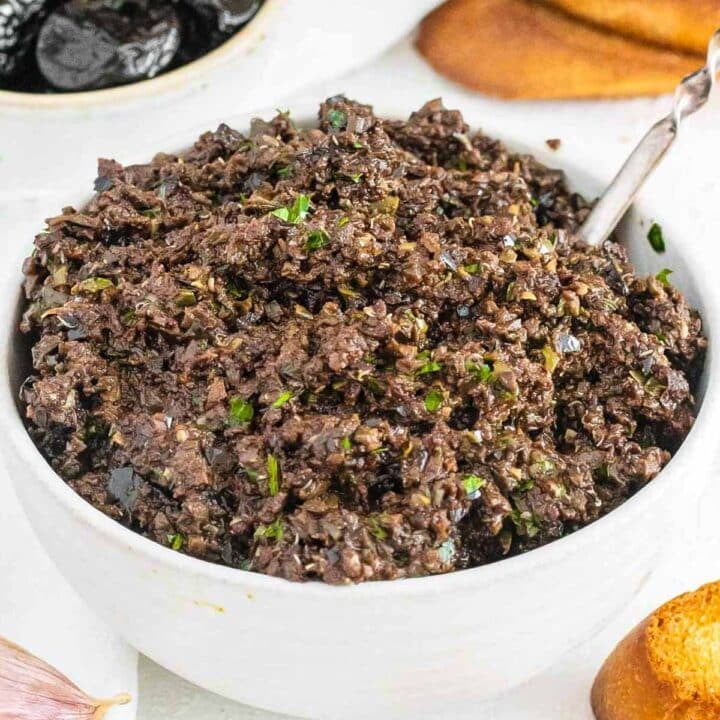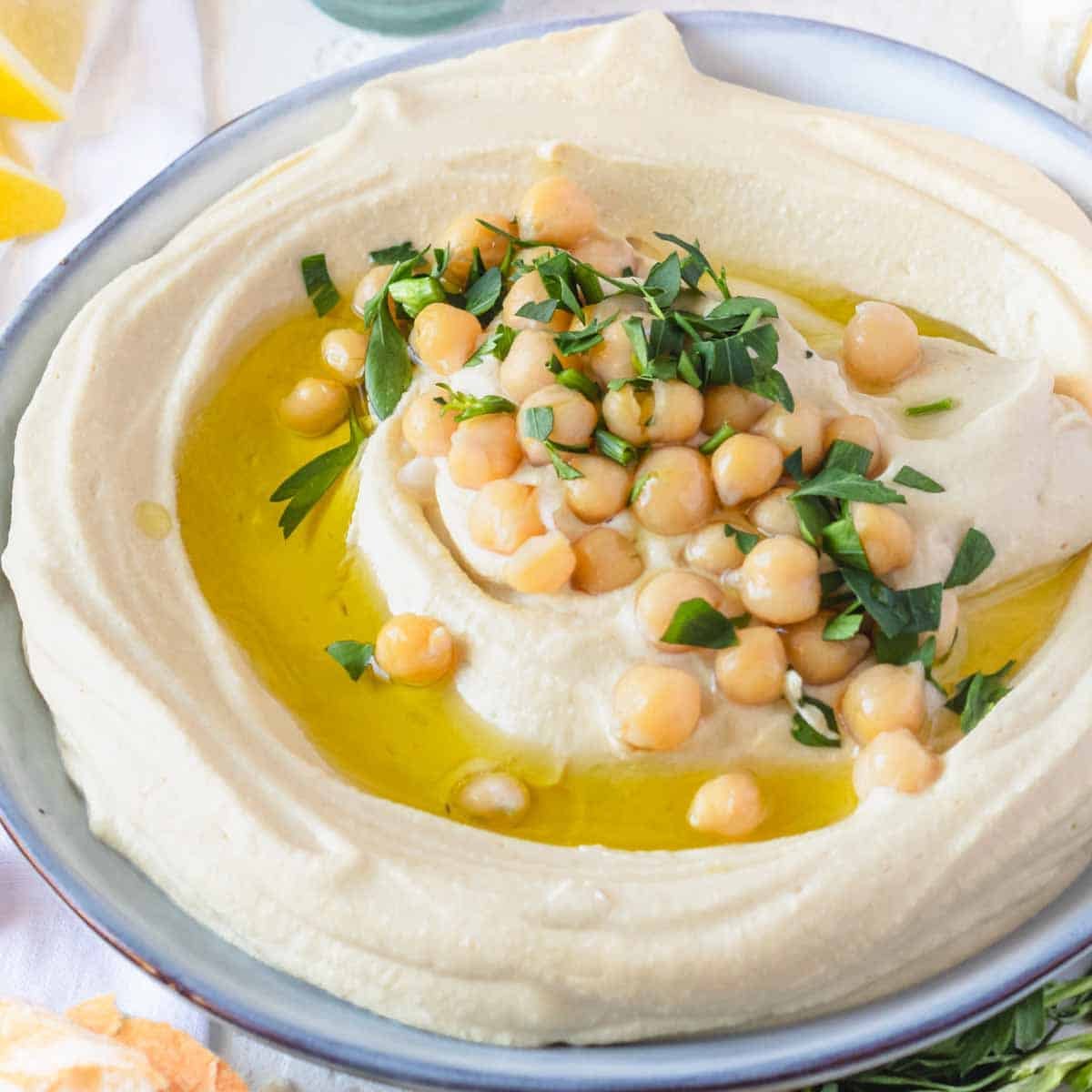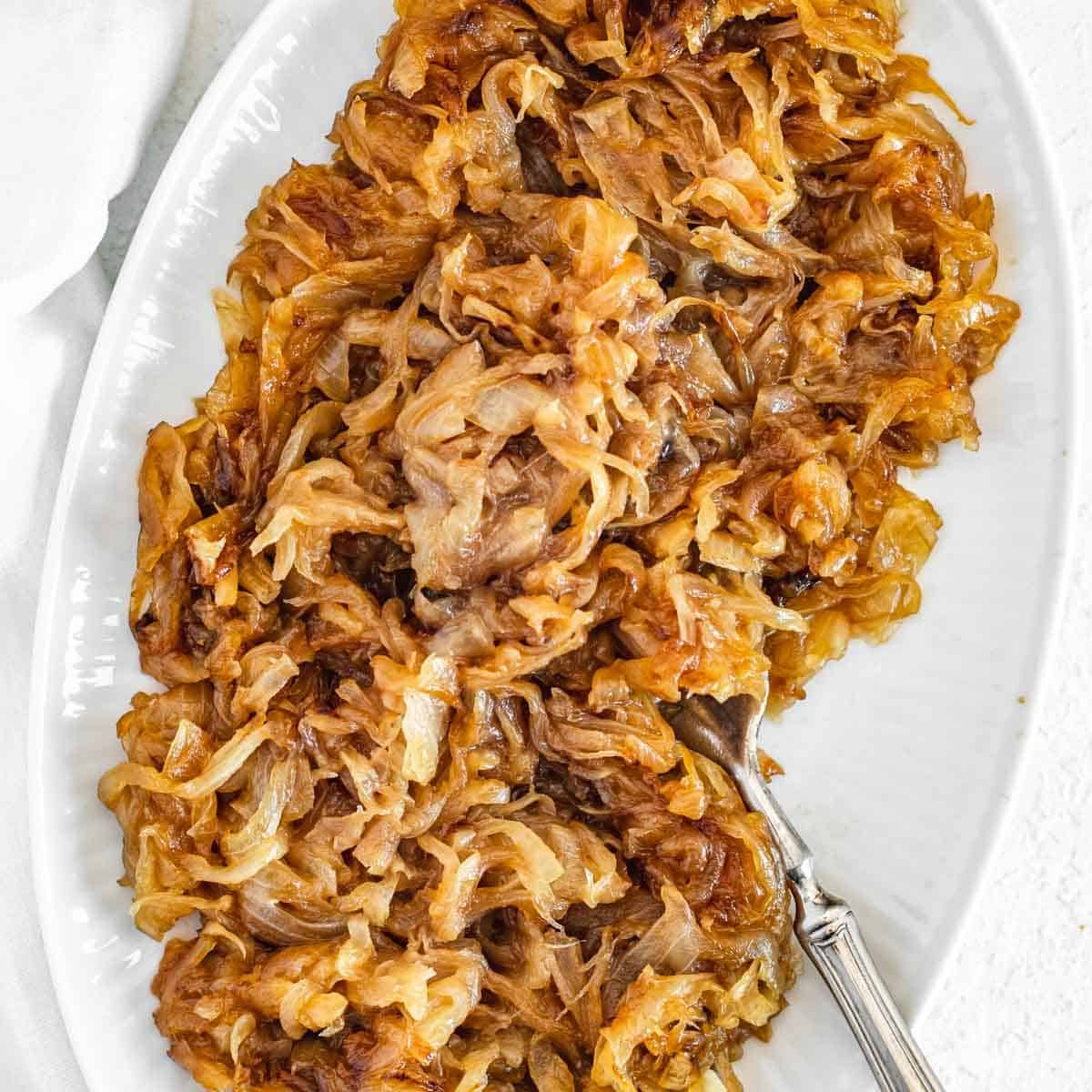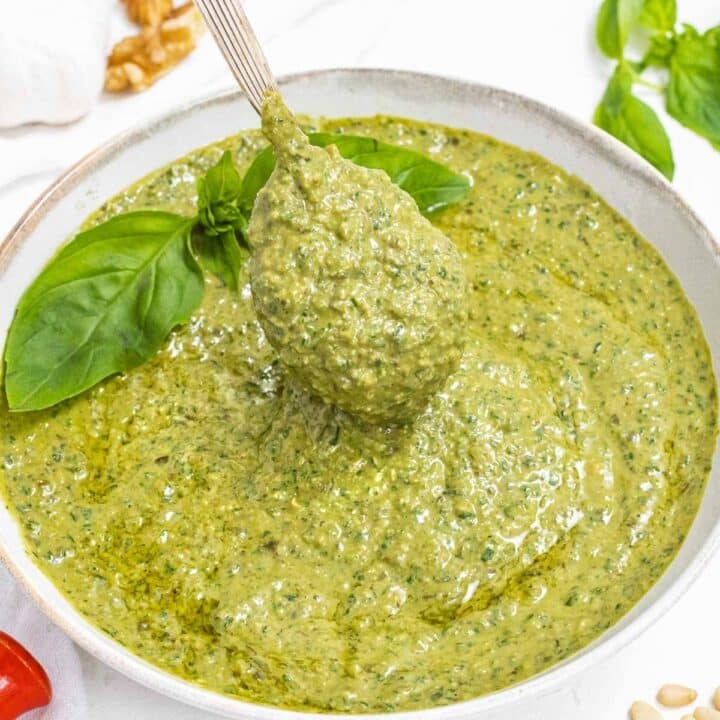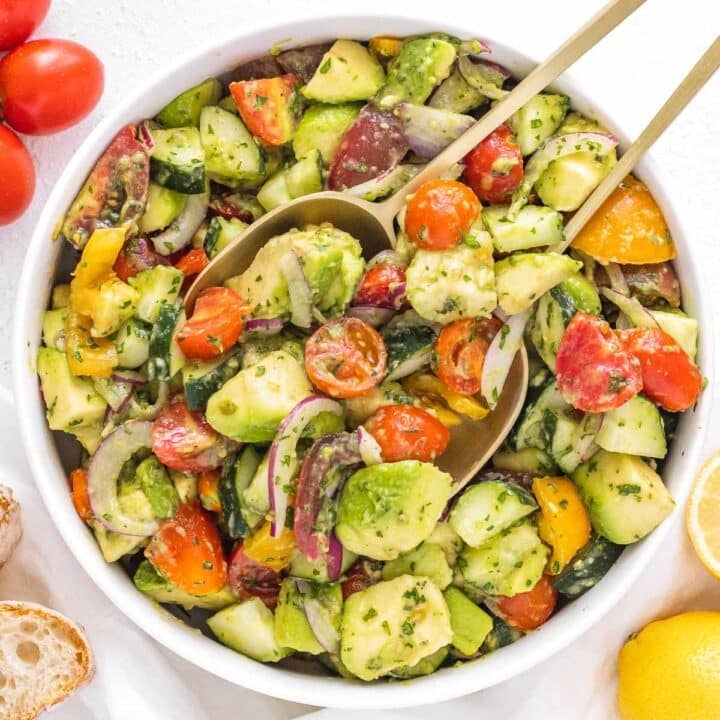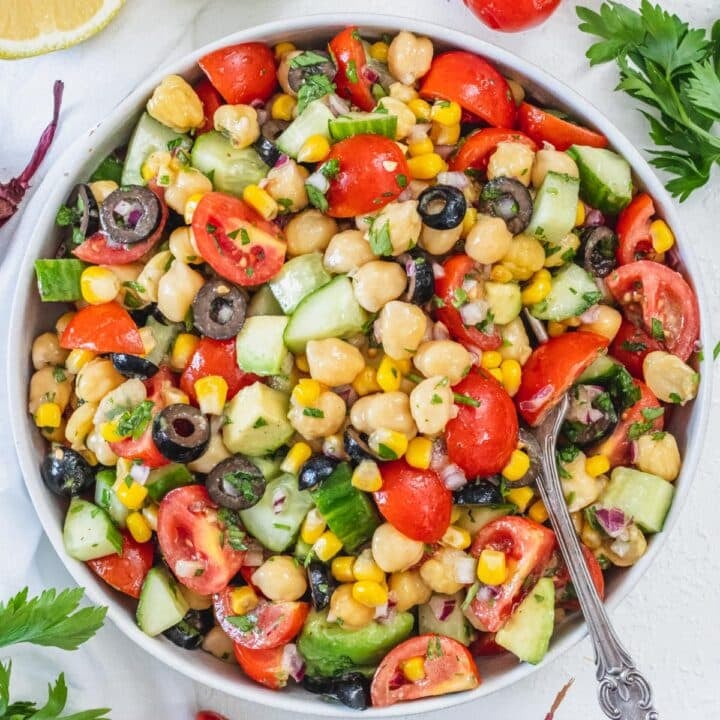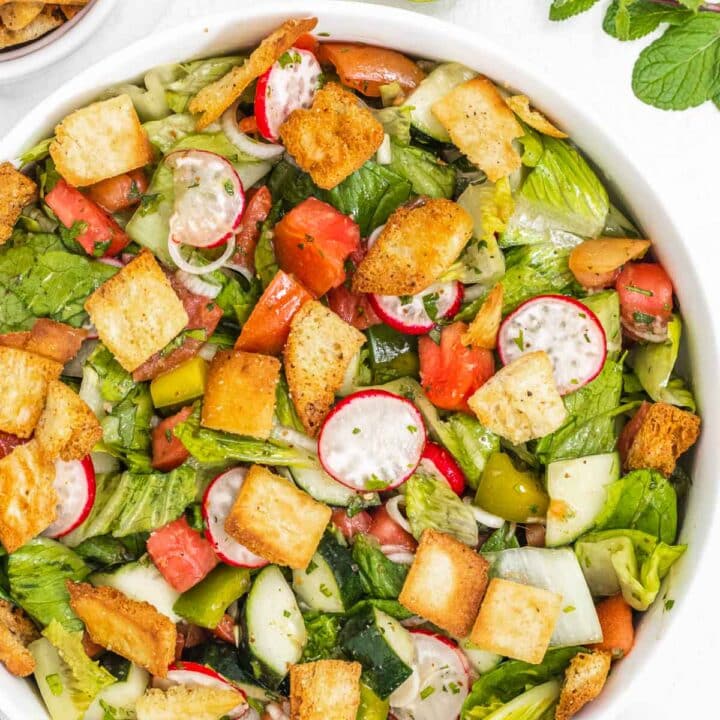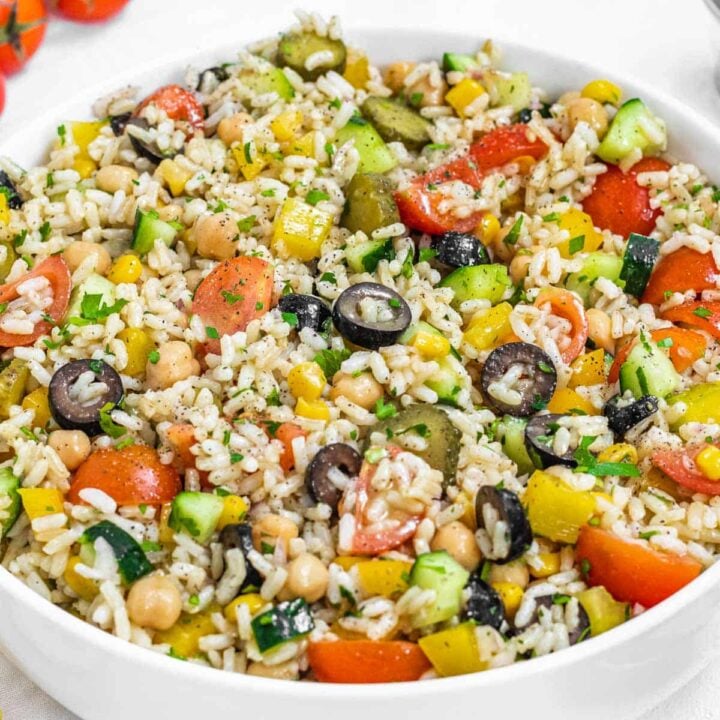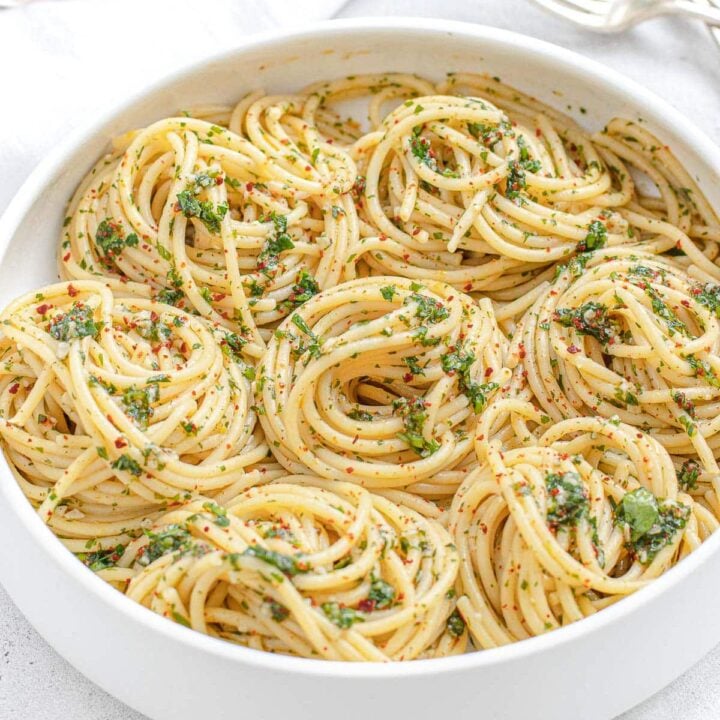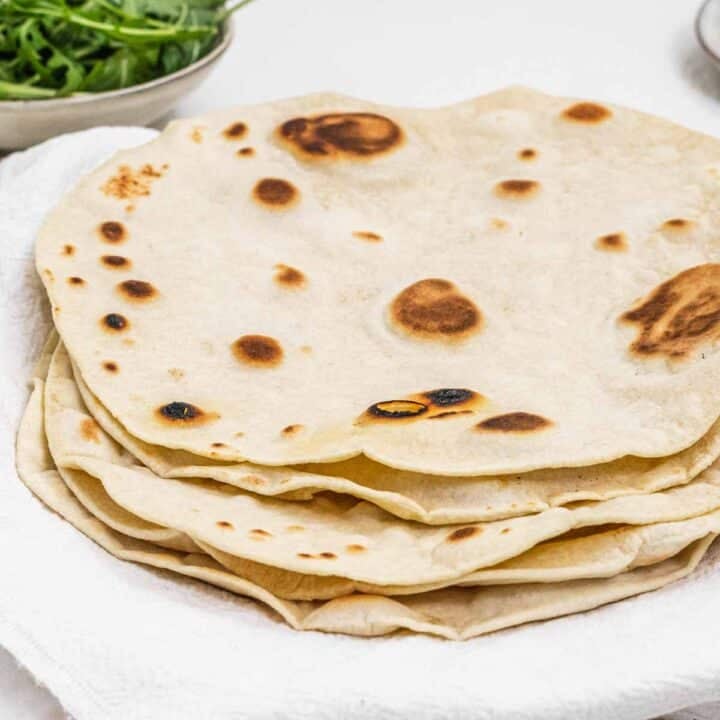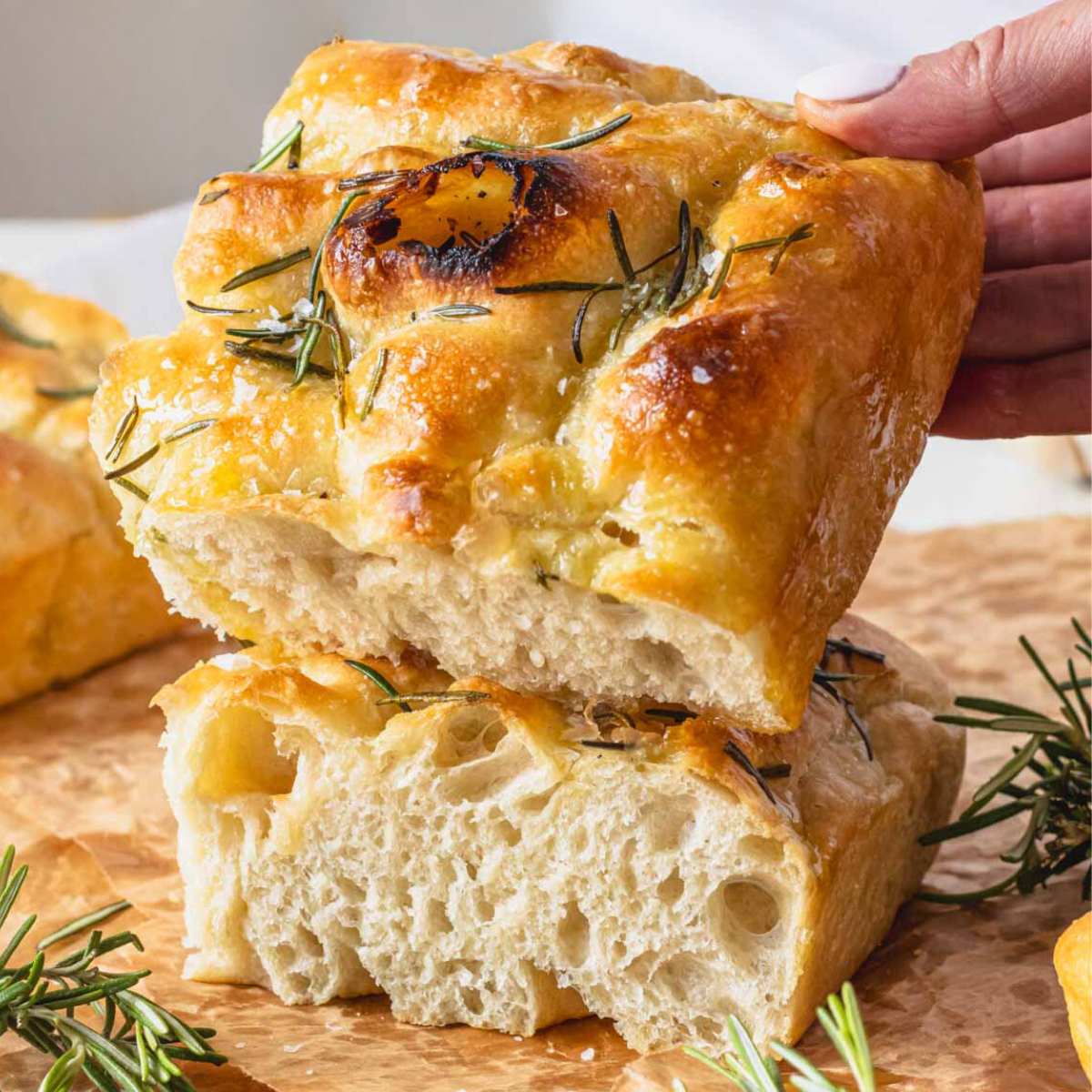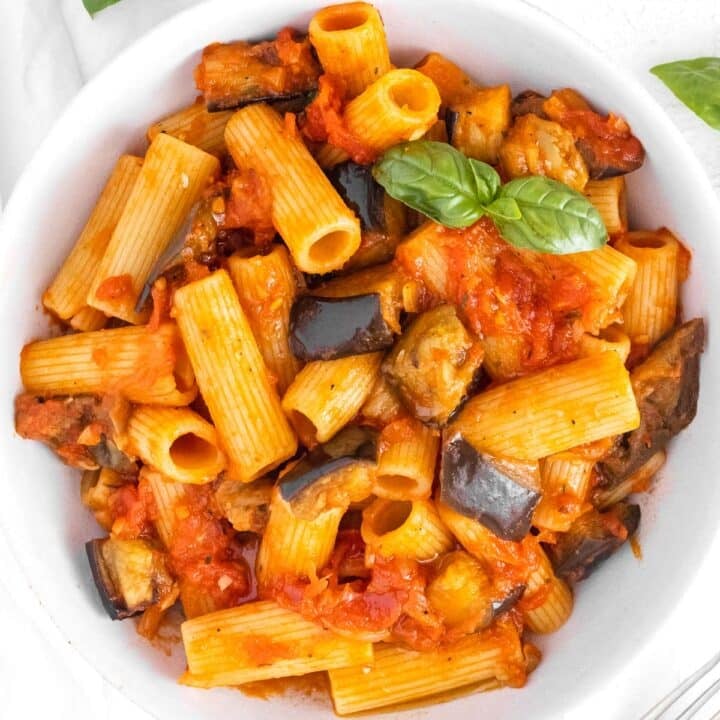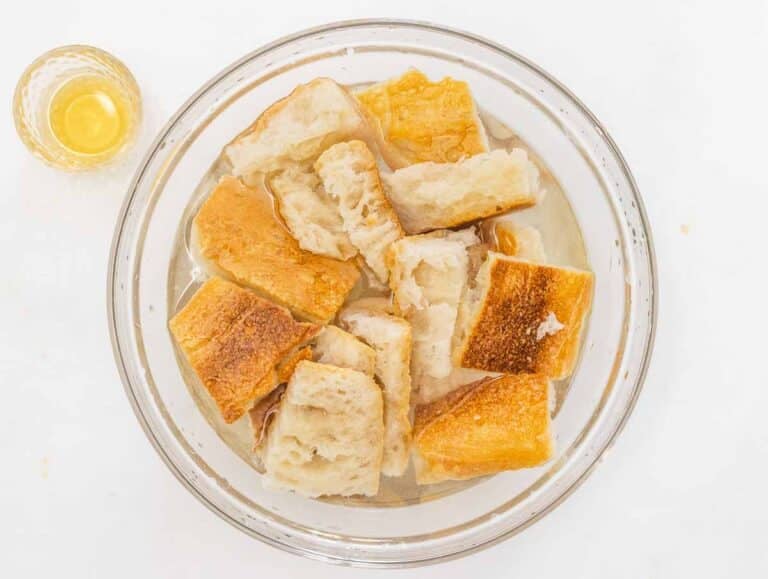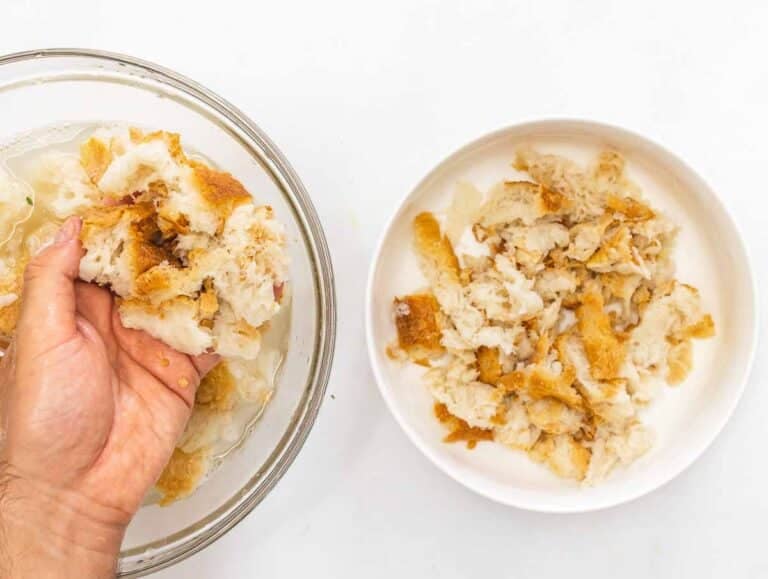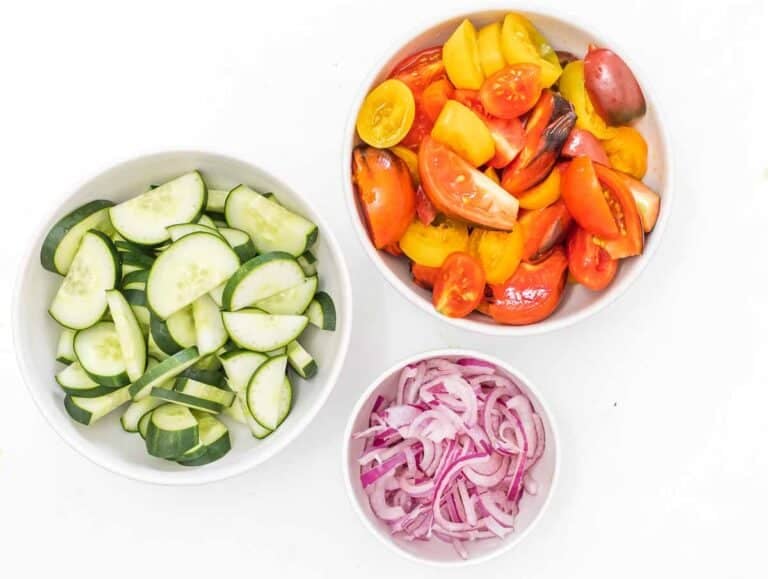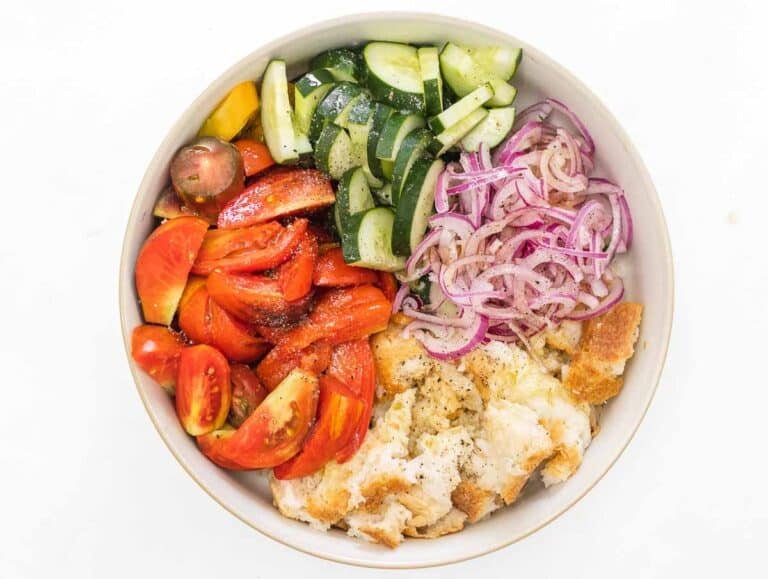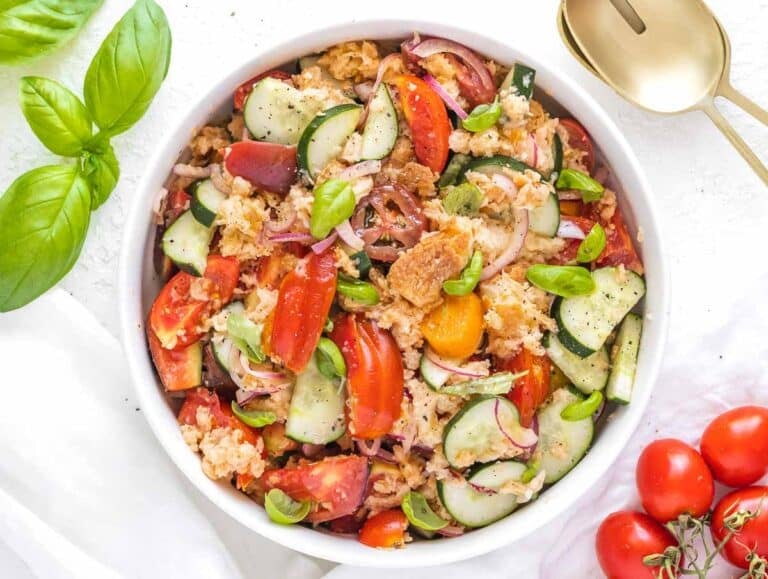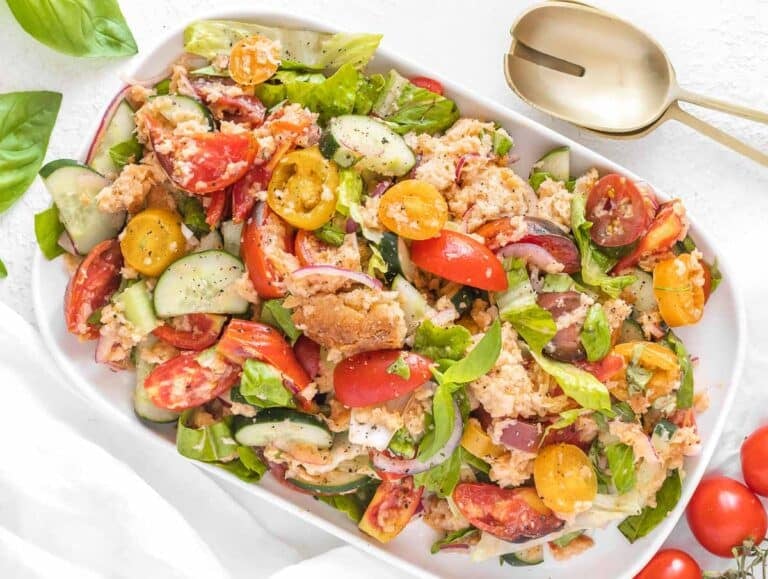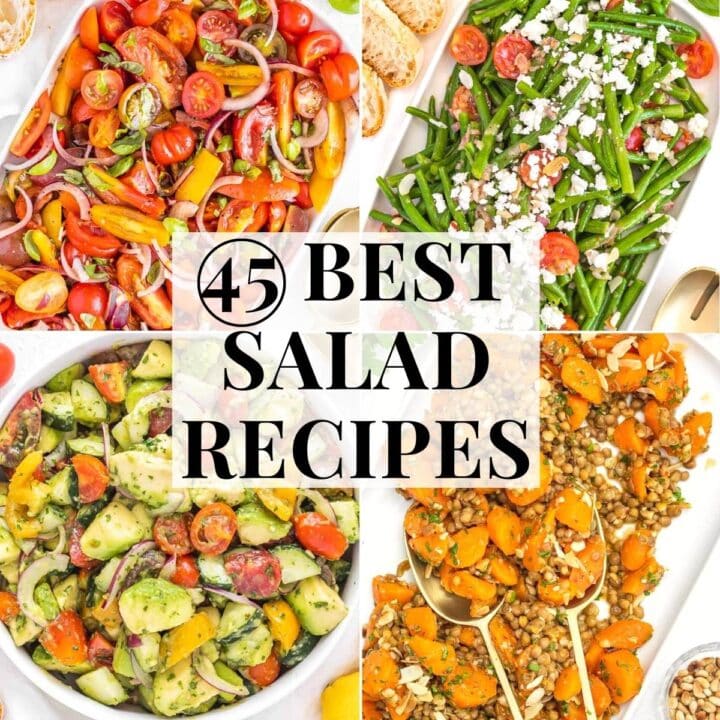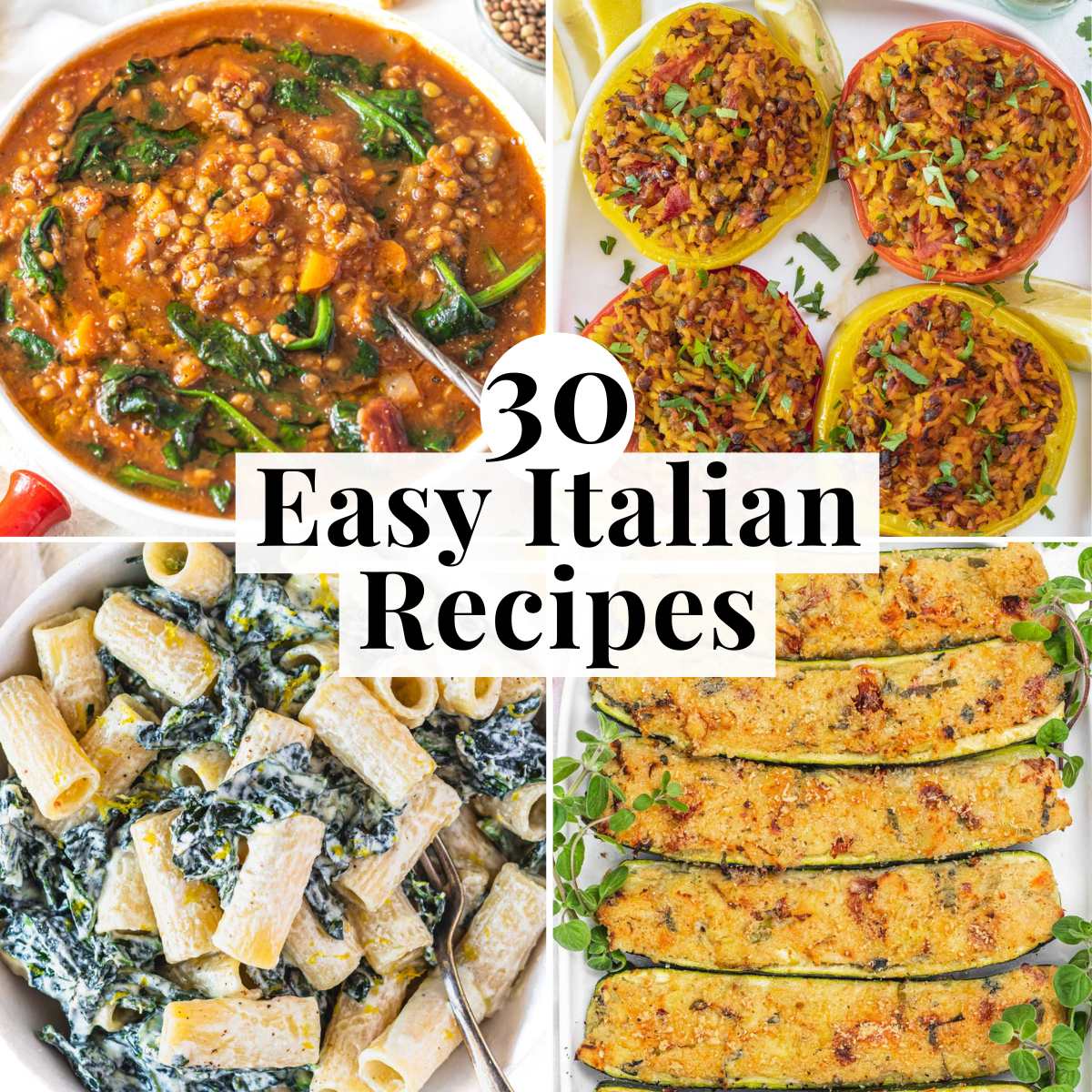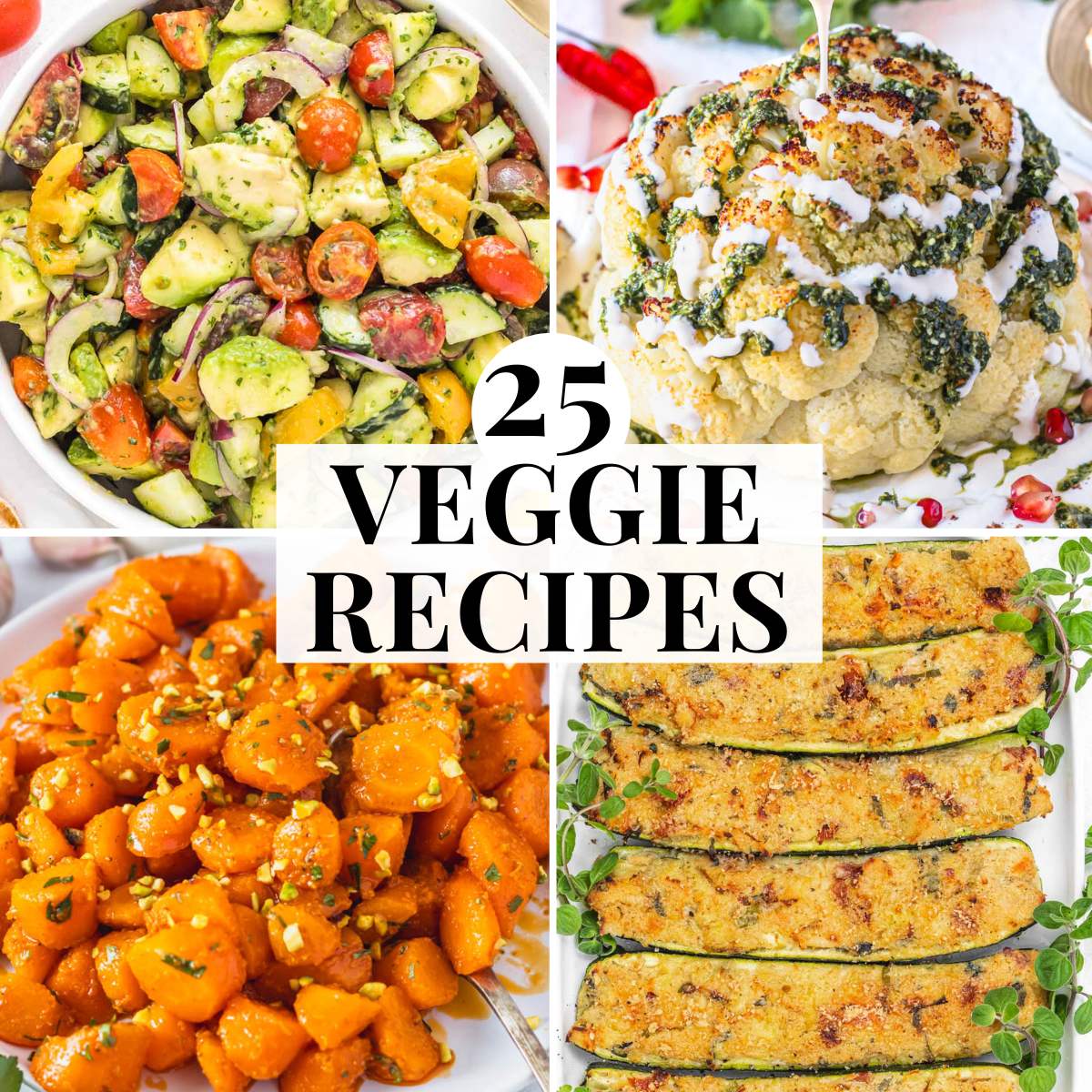Panzanella is a delicious bread salad from central Italy made with refreshing cucumbers, juicy tomatoes, fresh herbs, crusty or stale bread, and a simple seasoning of olive oil and vinegar.
Panzanella is the perfect summer recipe; it’s easy to make and customize, refreshing, colorful, and wonderful as an appetizer, light lunch, or side dish.
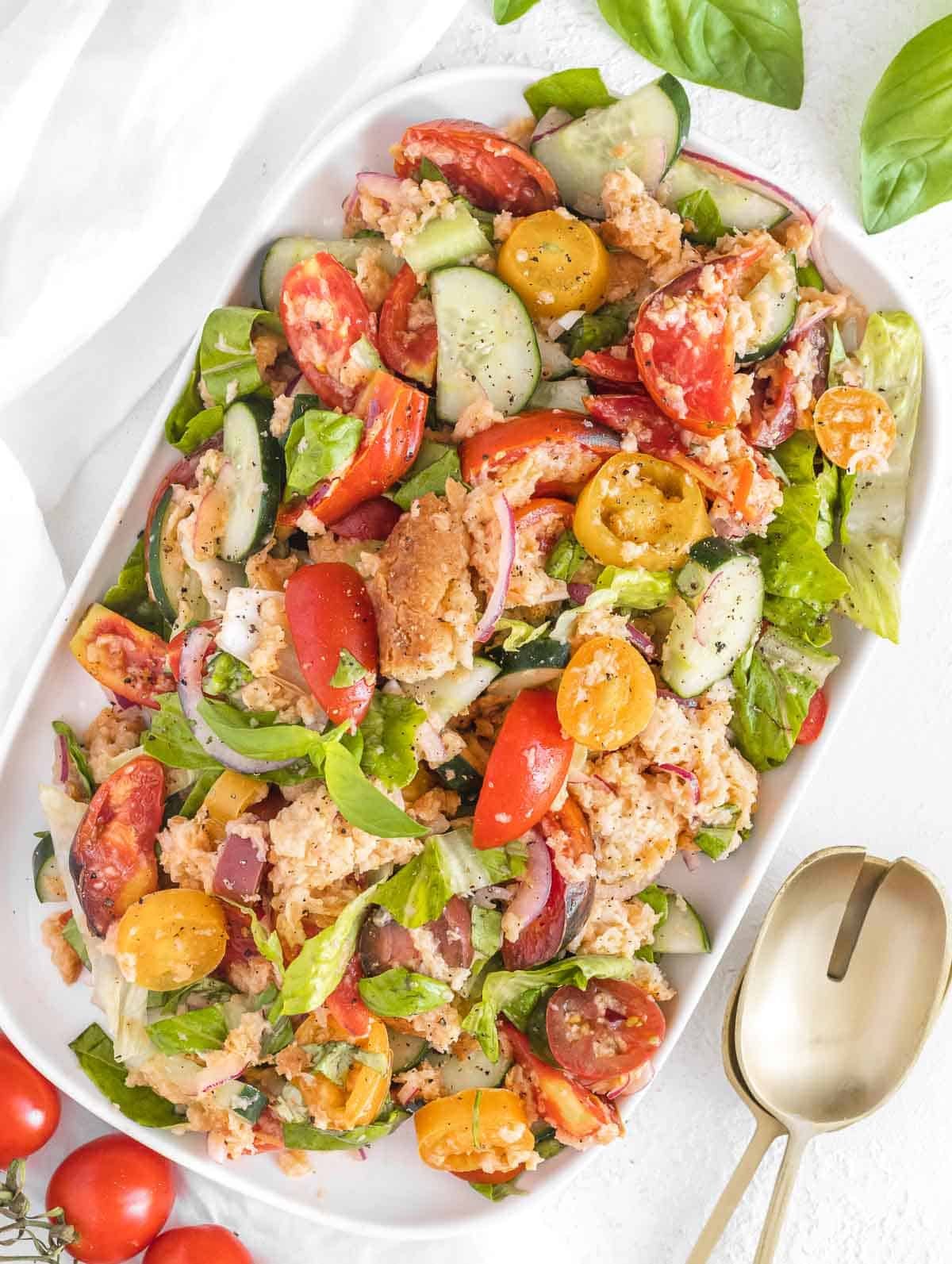
Table of Contents
Check out our Best Salad Recipes
Panzanella is an Italian bread salad originating in the centenary traditions of central Italy, especially in the Umbria, Tuscany, Lazio, and Marche regions.
The flavor and texture of Panzanella salad are impressed in my memory like a Proustian madeleine, as this has always been my favorite summer salad growing up, and it’s still associated with a feeling of freedom, safety, and happiness.
Crusty or stale bread soaked in water and vinegar absorbs the tomato and onion juices and flavors like a sponge becoming incredibly tasty.
This tasty bread, combined with crisp cucumber, meaty tomatoes, tangy red onion, and fruity extra virgin olive oil, creates an irresistible palette of textures and flavors. And all that with very basic, fresh, everyday ingredients.
There are many versions of Panzanella; some people add carrots and celery, and others add lettuce and vegetables. Take this recipe as a guideline, and add the summer veggies you have available where you live.
Here I will show you my grandma’s recipe, which I ate growing up in Todi, Umbria, and the one you’ll find in most local trattorias in central Italy.
Panzanella was and still is a simple and humble salad, created from the need of rural farmers to use what was available at home without spending a penny.
It’s a naturally vegan, zero-waste recipe and an excellent way to use stale bread.
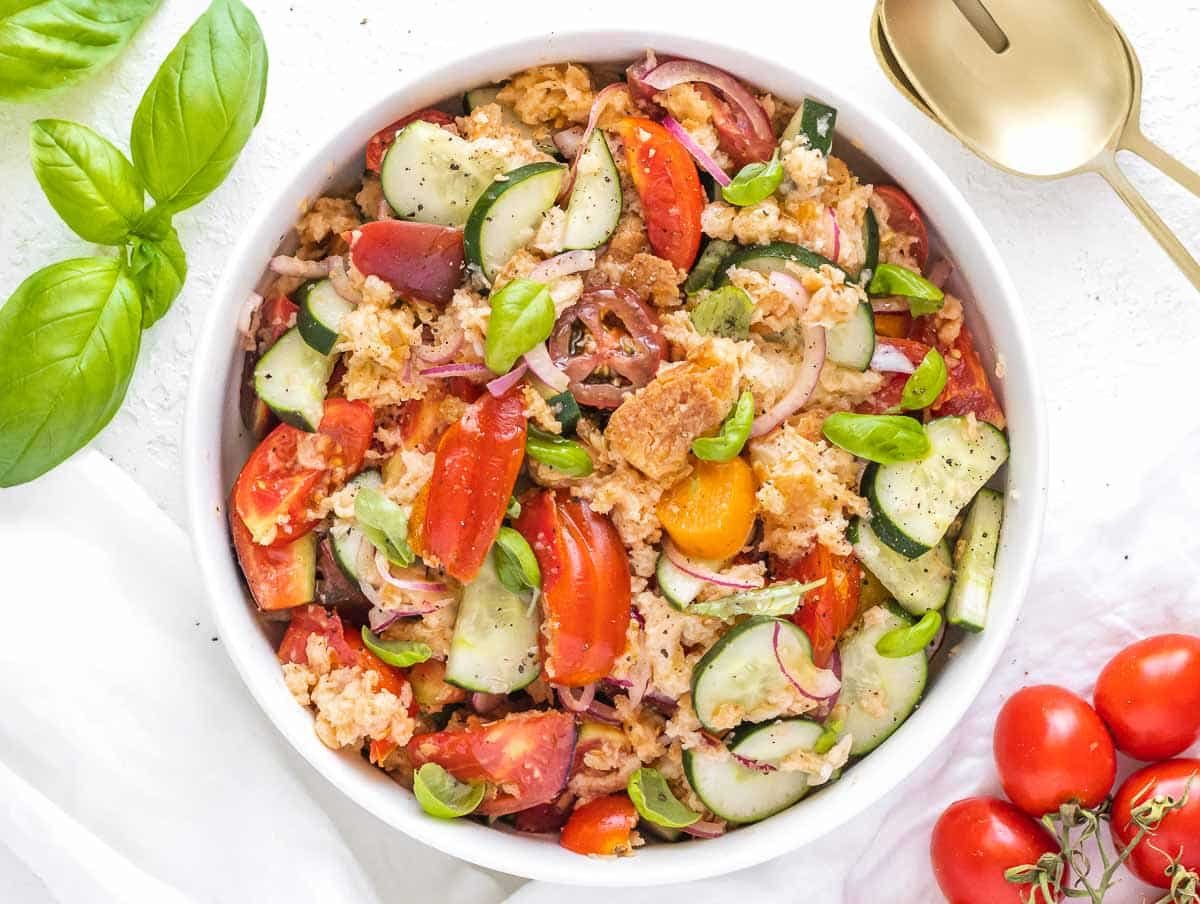
Ingredients
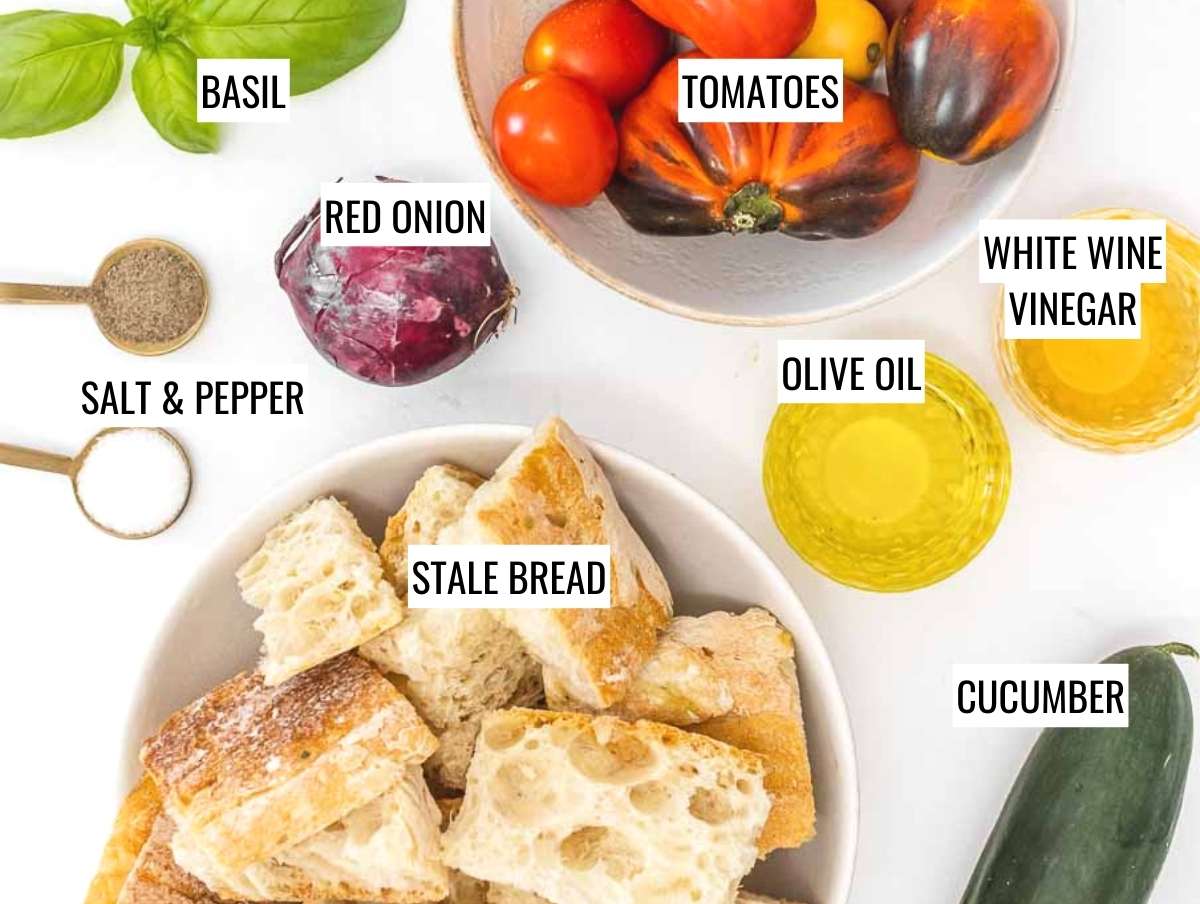
Bread
One to two days old stale bread is best to make Panzanella. Ideally, use crusty bread with a compact crumb to absorb the liquid without falling apart.
Sourdough bread, rustic bread loaves, ciabatta bread, and most artisanal loaves of bread are great options.
Avoid baguettes and packaged bread such as sandwich bread, rolls, and buns. They’ll fall apart as you soak them and will get mushy.
Tomatoes
Panzanella is essentially a tomato salad. As the main ingredient, try to use good quality tomatoes, like those in a farmer’s market.
The tomatoes should be ripe but firm to the touch. They should also be consumed at room temperature to appreciate their taste fully.
You can mix more tomato varieties, and locals in Italy use what they have at hand without being too fussy.
Our favorites are San Marzano tomatoes, Heirloom tomatoes, cherry tomatoes, and Roma tomatoes, but most tasty ripe tomatoes will do.
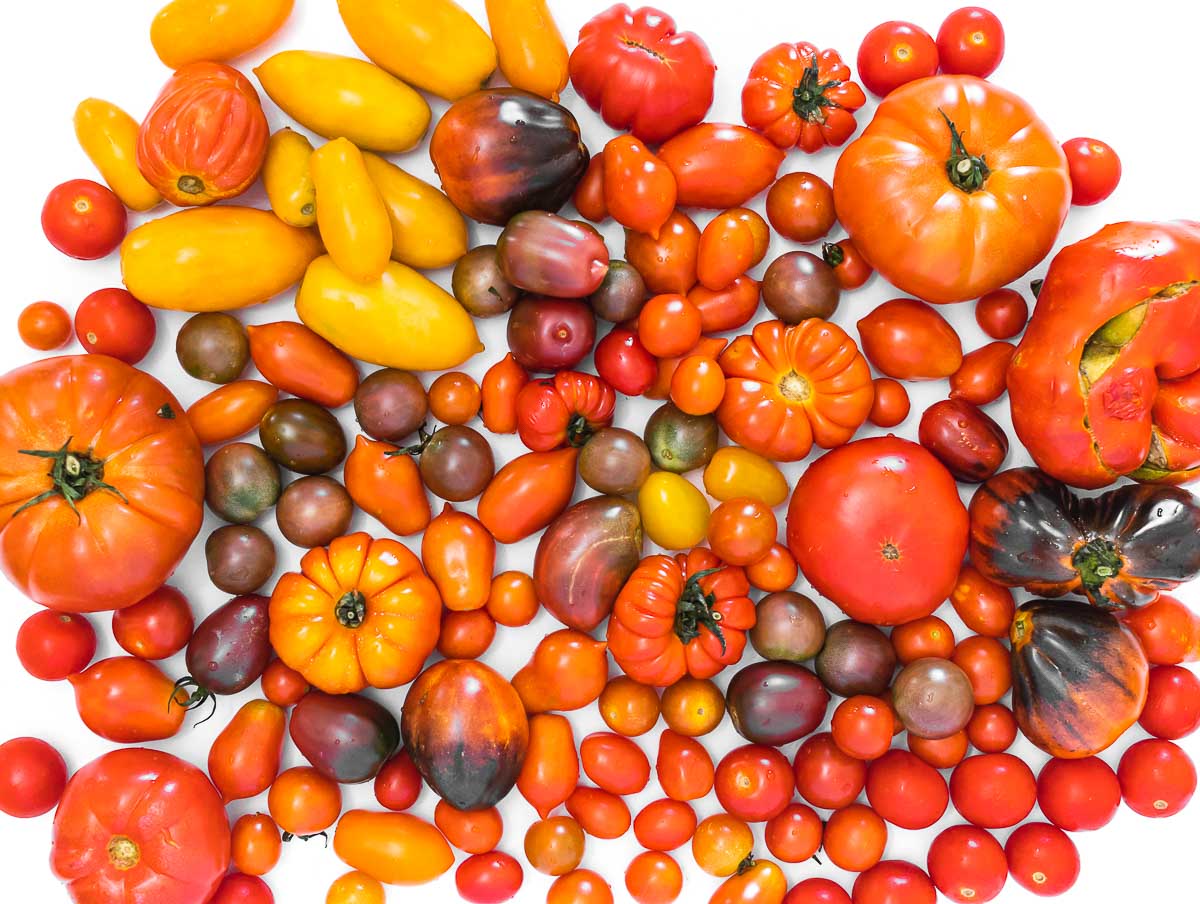
Cucumber
You can use garden cucumber, English cucumber, or Persian cucumber. You can keep the peel on or peel it off if you prefer.
Red onion
Red onion adds a sharp flavor that fits perfectly with the Panzanella salad. Slice it as thinly as possible, and if the onion is too strong for you, you can soak it in cold water for ten minutes before adding it to the rest of the ingredients.
Basil
Fresh basil adds a mellow, sweet, and round aroma. I have never replaced basil with any other fresh herb in Panzanella.
However, if you’d like to, you could substitute other fresh herbs such as parsley, oregano, thyme, and dill for basil.
Lettuce
Lettuce is optional. Some Italian Panzanella salad recipes include lettuce; others don’t. We made one with lettuce to show you how it looks, and we loved it.
We recommend Romaine lettuce.
Olive Oil
Use extra virgin olive oil if possible. It adds a richer, fruitier flavor than regular olive oil.
Vinegar
There’s no hard rule about vinegar, and you can use white wine vinegar, red wine vinegar, apple cider vinegar, and balsamic vinegar.
However, if you use balsamic, the bread will look darker. So we use white wine vinegar.
Salt and Pepper
Season Panzanella with a good pinch of sea salt (or kosher salt) and a few twists of freshly ground black pepper.
Ingredients that are not in Panzanella but you can add if you like
Authentic Panzanella salad contains no garlic, homemade croutons, dijon mustard, capers, fresh mozzarella, parmesan, or any other type of cheese, red or yellow bell pepper, chicken, or shrimp.
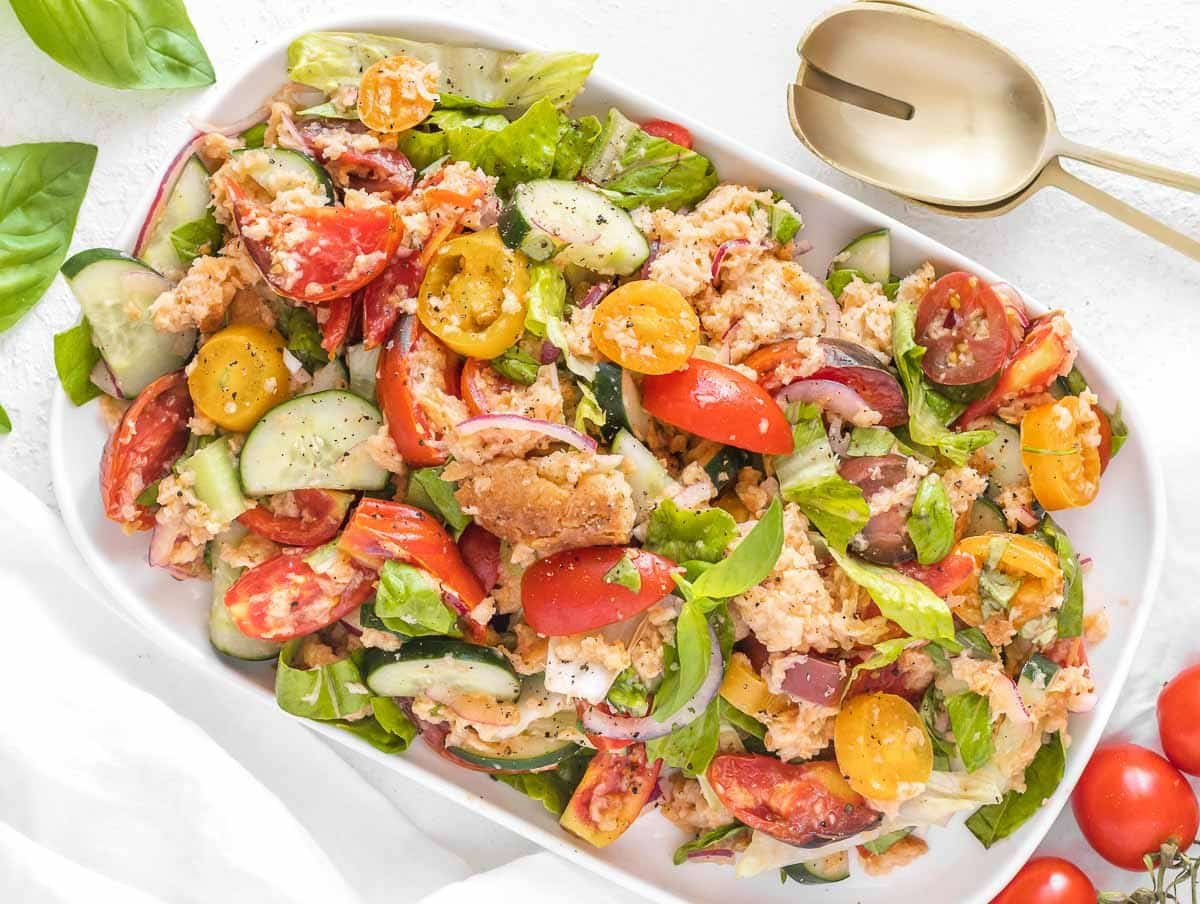
Instructions
Break the stale bread into big chunks and add them to a bowl. Cover them with water and two tablespoons of vinegar.
Soak until the bread becomes soft. It can take 5 to 30 minutes for the bread to soften up, depending on how dry it is and the type of bread.
Tip: If you don’t have stale bread, you can dry fresh bread in the oven. Bake it on a baking sheet for 15 to 30 minutes at a low temperature (210˚F or 100˚C).
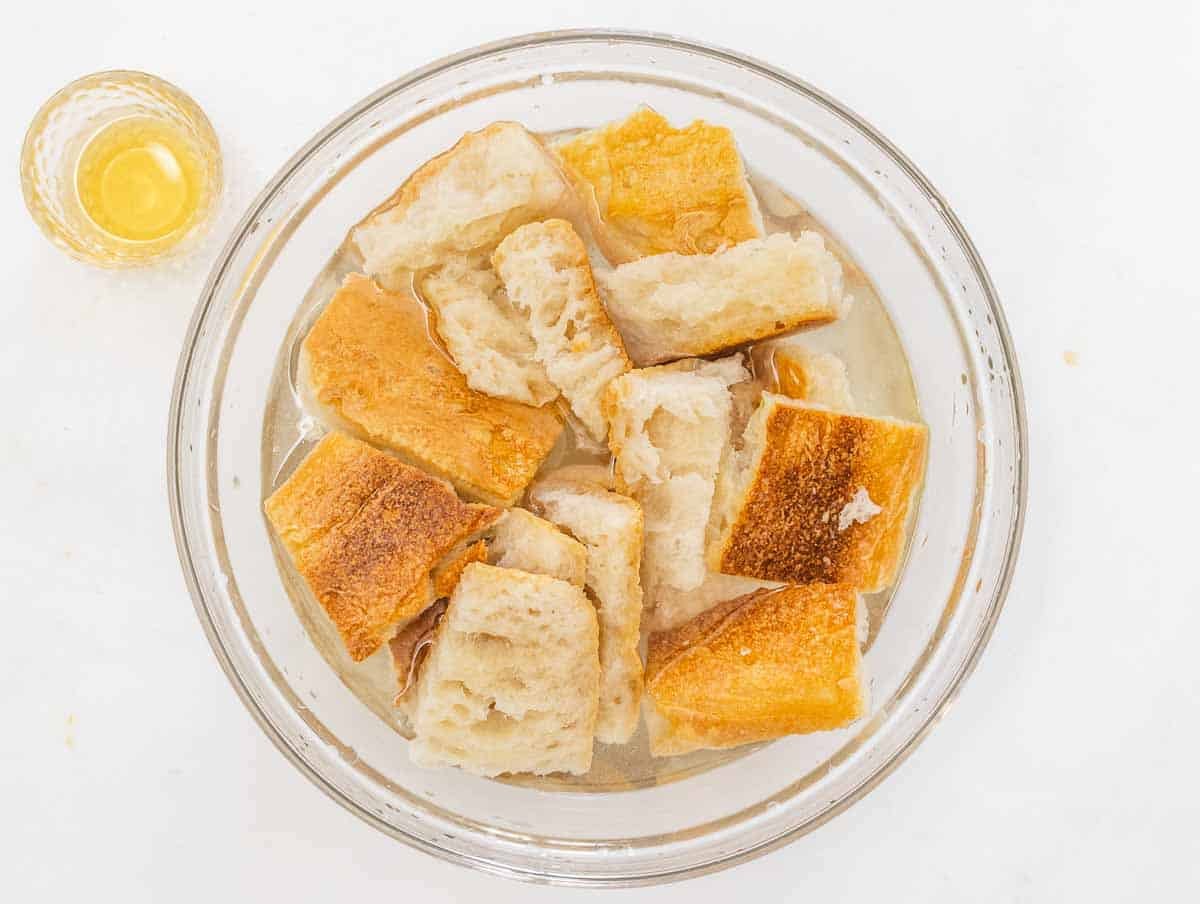
With your hands, squeeze the water out of the soaked bread, then coarsely crumble it into a large bowl. There’s no need to have neat bread cubes.
Tip: Don’t let the bread soak too long, or it’ll get mushy. Some of the bread pieces should be harder than others. The crust especially can retain some bite to it.
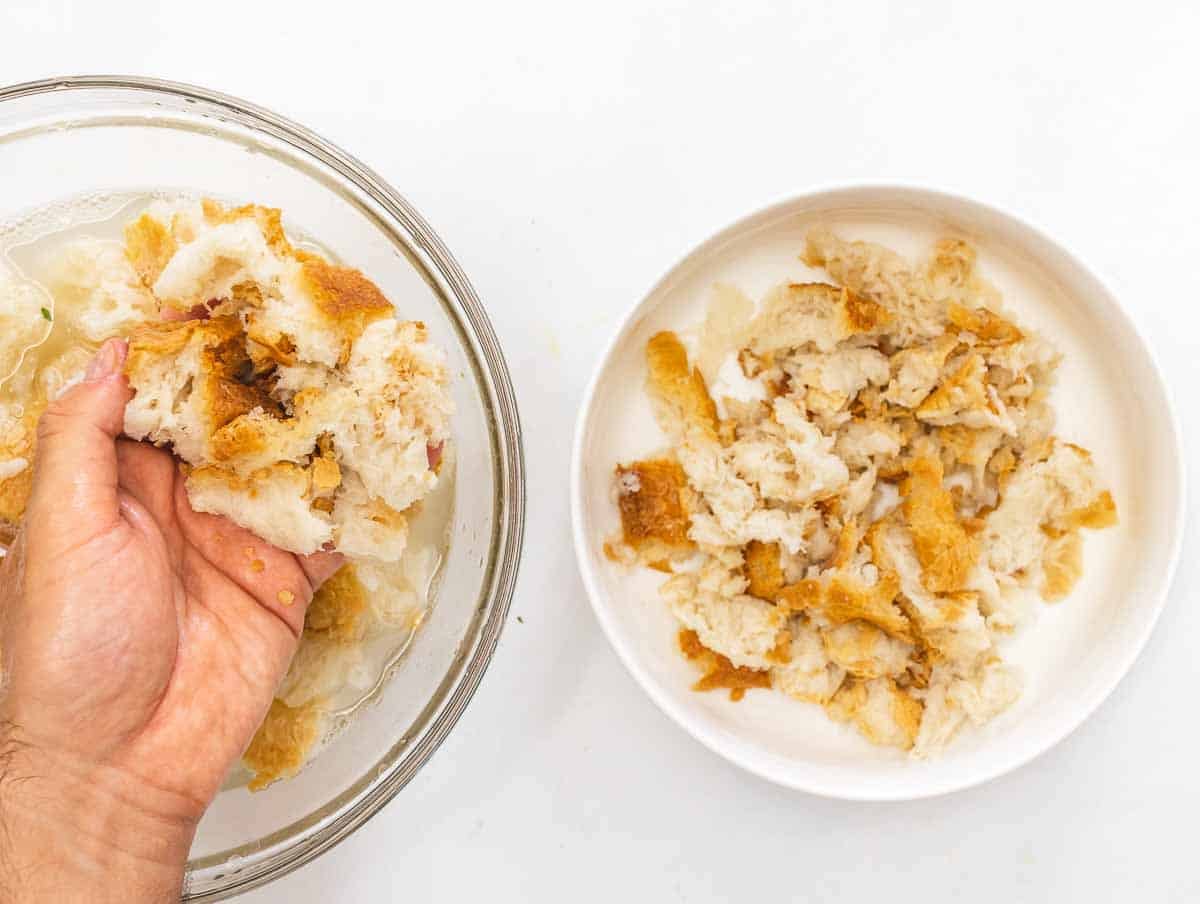
Cut the cucumber half lengthwise, then cut each half into thin slices.
Next, cut the red onion in half, peel it, then cut it into thin slices.
Finally, dice the tomatoes into bite-size pieces. Don’t discard the tomato juice.
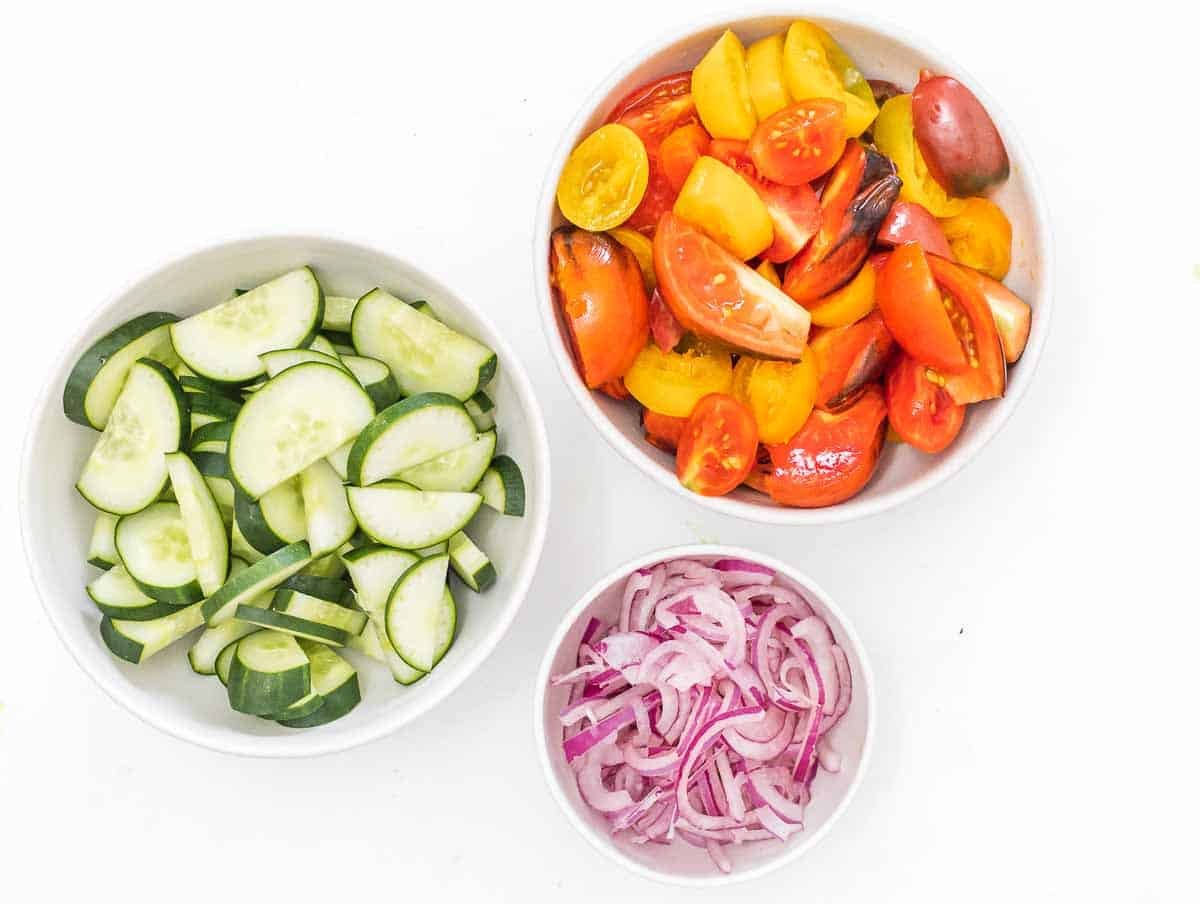
Add tomatoes (with their juice), cucumber, red onion, soaked and squeezed bread, salt, pepper, extra virgin olive oil, the remaining vinegar, and fresh basil leaves to a large mixing bowl.
Tip: there’s no need to whisk the condiments into a vinaigrette. That’s not customary in a classic Panzanella salad.
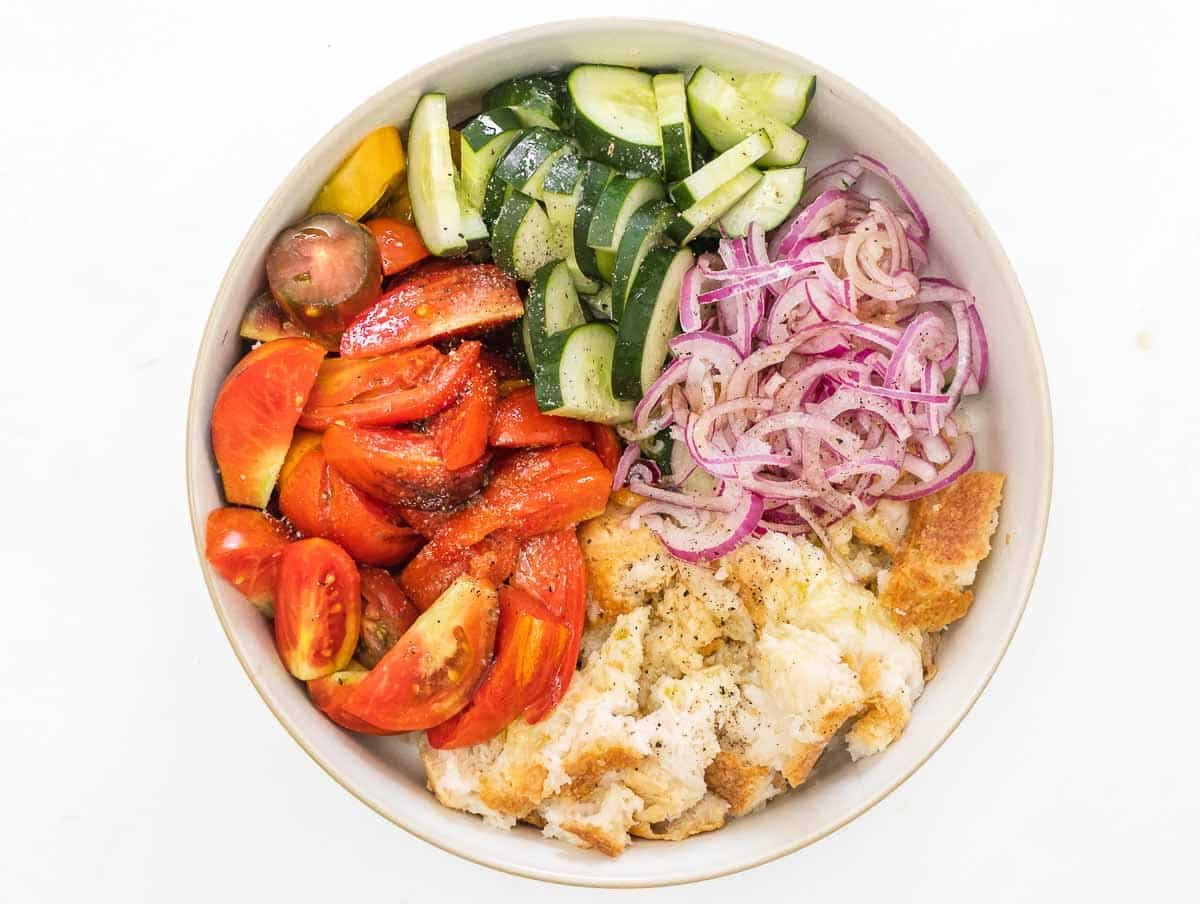
Toss well and set aside 10 to 30 minutes before serving.
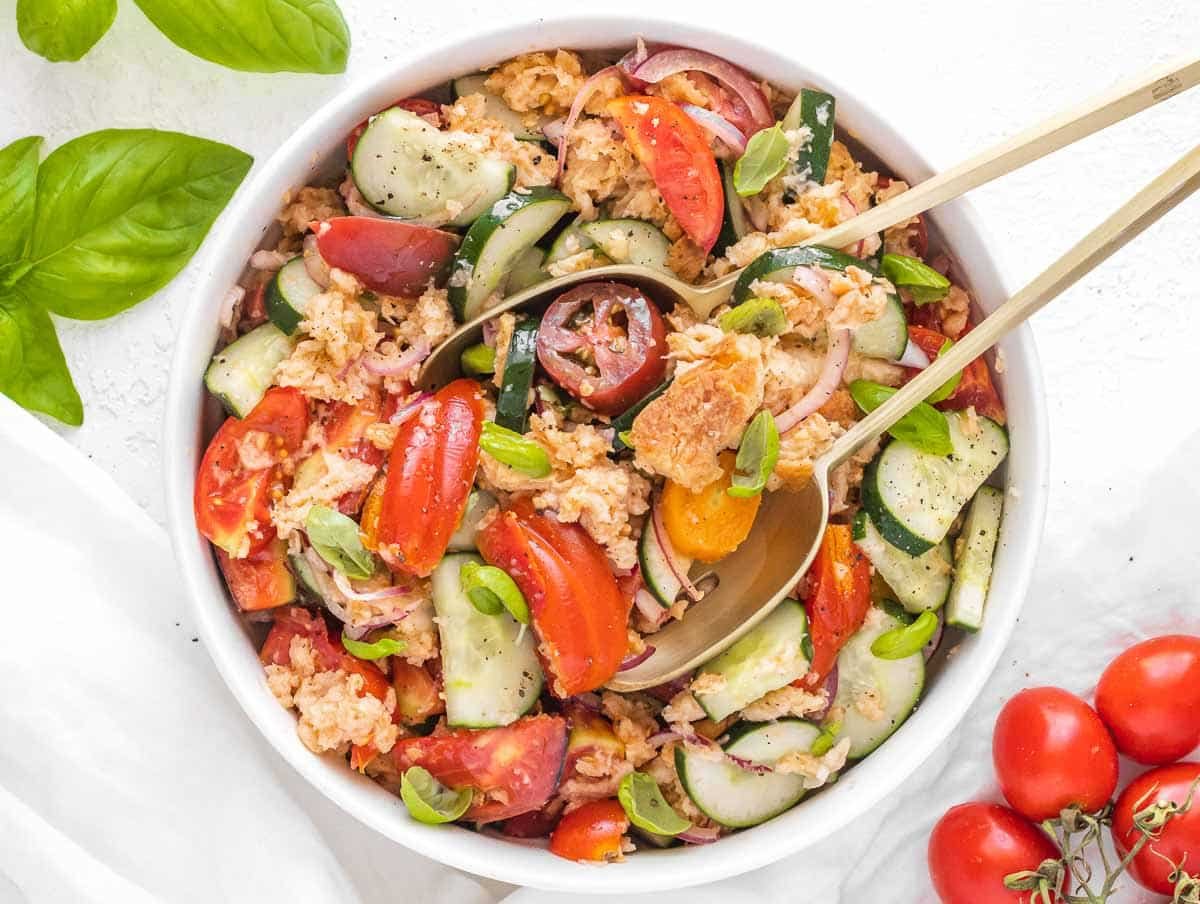
Serving suggestions
As an appetizer
Serve Panzanella in small portions or on a platter as an appetizer. It goes well with:
- Bruschetta (bread, garlic, tomatoes, balsamic vinegar, olive oil, fresh basil, etc.)
- 10-minute crostini (bread, olive oil, garlic, salt, pepper)
- Olive tapenade (olives, olive oil, capers, garlic, parsley, lemon juice, etc.)
- Homemade hummus (chickpeas, tahini, lemon, garlic, cumin, parsley, etc.)
- Caramelized onion (onion, sugar, vinegar, olive oil, salt, etc.)
- Basil pesto (dairy-free: basil, pine nuts, walnuts, nutritional yeast, olive oil, etc.)
For lunch
Serve a larger portion and make it a main meal for a quick, easy, and healthy lunch by adding olives, chickpeas, and beans. You can even add some crumbled feta cheese.
Panzanella is excellent for a vegetarian lunch because it feels light, but it’s fulfilling at the same time.
As a side dish
Try Panzanella next to:
- Aglio e Olio with white beans (spaghetti, parsley, garlic, red pepper flakes, olive oil, etc.)
- Eggplant Parmigiana (roasted eggplant, canned tomatoes, garlic, basil, parmesan, or dairy-free cheese, etc.)
- Tomato risotto (tomato passata, arborio rice, vegetable broth, butter, basil, etc.)
- Chickpea soup (celery, onion, carrot, chickpeas, rosemary, vegetable broth, etc.)
- Tuscan bean soup (leafy greens, white beans, tomato puree, cabbage, garlic, etc.)
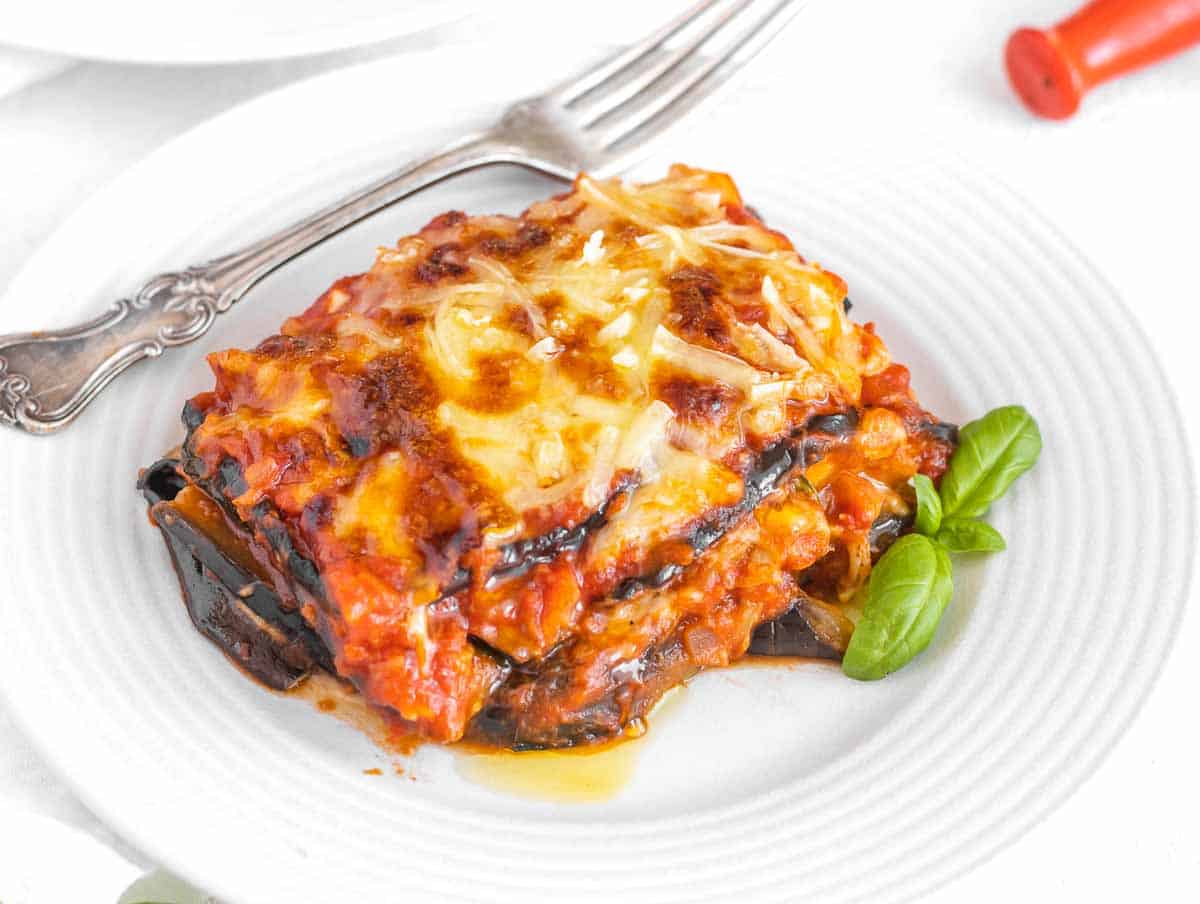
Variations
Panzanella with lettuce

This Panzanella salad recipe is popular in the most central Italian region, Umbria. We love this version, which we usually make in our home.
Pick some fresh and crunchy Romaine lettuce, chop it up, and add it to the bowl with the remaining ingredients.
Panzanella Romana
In some areas in central Italy near Rome, you’ll see a version of Panzanella that looks more like Bruschetta with tomatoes. Wet slices of stale bread with water and top with chopped tomatoes, basil, vinegar, and olive oil.
Panzanella Toscana
Choose unsalted artisanal white bread, just like Tuscan bread. Don’t add the lettuce. Sometimes in Tuscany, you’ll see the vegetables in the Panzanella cut into long thin slices. In some areas, they add celery.
Panzanella Pugliese
In Puglia, they often use Friselle instead of bread. Friselle are large, round pieces of dry, baked durum wheat flour, often with a hole in the center.
Winter Panzanella
We make this variation during the colder months. Use cherry tomatoes instead of vine tomatoes; add 1 cup (200 grams) of white cannellini beans instead of the cucumber.
Chickpea Panzanella
This is another of our favorite variations, as the chickpeas make this salad an excellent main dish with plenty of protein. We also add a sliced stalk of celery, a handful of arugula, and two grated carrots.

Tip
Let the flavors meld
If you have the time for it, let the Panzanella rest in the vegetable zone of your refrigerator for about 45 minutes to let the flavors meld together, then take it out of the fridge and keep it at room temperature for another 30 minutes before serving it.
Please don’t leave it in the fridge too long; your tomatoes will lose texture and flavor.
Questions
Yes, the original recipe for Panzanella is vegan, as it does not call for animal-based ingredients.
It comes from the central Italian regions of Umbria, Tuscany, Lazio, and Marche.
Panzanella is generally eaten as a side salad or in restaurants and pizzerias as an appetizer. At home, we like to eat Panzanella next to some grilled vegetables and hummus or next to one of our easy dinners.
The term probably comes from the combination of old Italian words “pan” (bread) and “zanella” (small bowl).
Panzanella does not store well in the fridge due to the wet bread, tomatoes, and vinegar. Our advice is to keep it for max up to half a day.
For best results, Panzanella should be made 1.5 hours before serving time, then stored in the fridge in the vegetable zone for about 45 minutes to let the flavors come together, and then let out at room temperature for another 30 to 45 minutes before serving.
However, if you want to make it in the morning for dinner service, don’t season it; add oil and vinegar just before serving.
Yes, but the result won’t be like authentic Panzanella. If you decide to soak your croutons, you might want to do it quickly, as they’ll lose structure and turn into a mash.
Storage
Make ahead: for best results, Panzanella should be made 1.5 hours before serving time, then stored in the fridge in the vegetable zone for about 45 minutes to let the flavors come together, and then let out at room temperature for another 30 to 45 minutes before serving.
Refrigerator: we recommend storing Panzanella for up to 12 hours in the refrigerator. Once out of the fridge, leave it at room temperature for at least 30 minutes.
Freeze: this recipe is not suitable for freezing.
More Salad Recipes
Get inspiration for your next salad from these wholesome dishes:
- Chickpea salad (chickpea, olives, tomatoes, corn, cucumber, shallot, lemon, olive oil, etc.)
- Rice salad (bell pepper, cucumber, pickled cucumber, olives, whole grain rice, tomatoes, etc.)
- Avocado salad (cherry tomatoes, avocado, lemon, red onion, basil, parsley, olive oil, etc.)
- Pesto pasta salad (basil pesto, arugula, cherry tomatoes, bow tie pasta, etc.)
- Fattoush (pita bread, radishes, tomato, romaine lettuce, cucumber, etc.)
More Italian Recipes
If you like Italian cooking and Mediterranean flavors, get some dinner inspiration from these Italian classics:
- Aglio e Olio pasta (parsley, olive oil, spaghetti, garlic, red pepper flakes, etc.)
- Piadina (flour, water, sugar, etc.)
- No-knead focaccia (instant dry yeast, flour, olive oil, sugar, salt, rosemary, etc.)
- Pasta alla Norma (eggplant, basil, canned tomatoes, rigatoni pasta, olive oil, etc.)
For many more side dish ideas, check out our sides category page.

Panzanella Salad
Ingredients
- ½ pound stale or crusty bread with a compact crumb
- 1 pound tomatoes chopped
- 1 cucumber chopped
- 1 red onion thinly sliced
- 8 lettuce leaves optional, chopped
- 15 basil leaves
- 4 tablespoons extra virgin olive oil
- 4 tablespoons vinegar
- 1 teaspoon sea salt
- ¼ teaspoon black pepper
Instructions
- Break the stale bread into big chunks, add it to a bowl, and cover with water and 2 tablespoons of vinegar.Soak until soft – 5 to 30 minutes depending on the bread.Tip: If you don't have stale bread, you can dry fresh bread in the oven or air fryer for 20 minutes at 210˚F or 100˚C.
- Squeeze the water out of the soaked bread, then coarsely crumble it into a large bowl.
- Chop cucumber and tomatoes, thinly slice the onion, and add all to the bowl with the bread.
- Season with extra virgin olive oil, the remaining vinegar, and fresh basil leaves.
- Toss well and set aside 10 to 30 minutes before serving.
- Lettuce is optional, if you like to add it, chop it first into bite-size pieces and toss it in with the other veggies.
Video
Notes
Nutrition
If you liked this Panzanella salad, you might also like:
[adthrive-in-post-video-player video-id=”Nb7IWSpI” upload-date=”2023-05-05T16:21:10.000Z” name=”Panzanella Salad” description=”I’ll show you how to make a 100% authentic Panzanella recipe. The exact recipe you’ll find in restaurants in central Italy, where Panzanella is from. The same recipe my grandma made for me growing up.” player-type=”default” override-embed=”default”]
